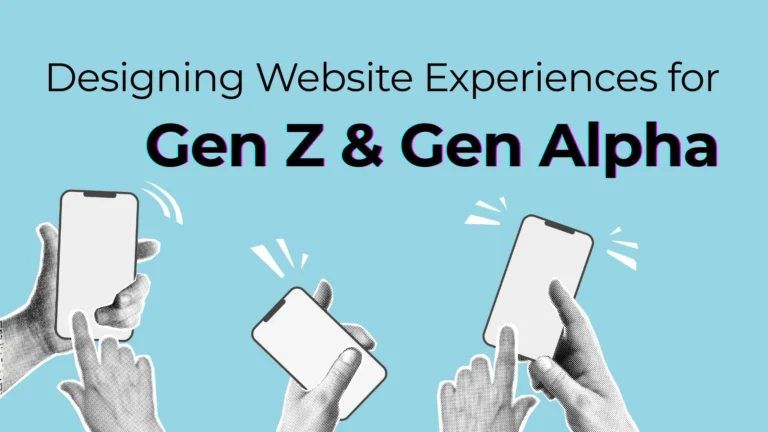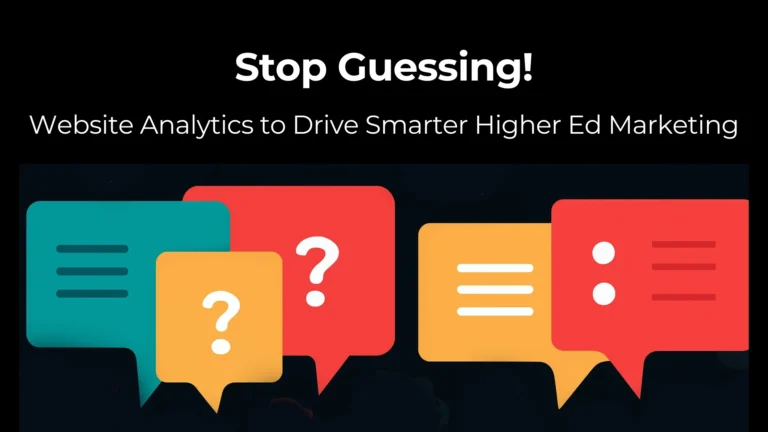Your .edu website is your always on communication tool. It guides and answers questions for prospective students and their families twenty four hours a day, seven days a week. Guiding these visitors from curiosity to confidence through a series of small but meaningful actions known as micro-conversions. These include clicking into a program page, filling out a short Request for Information (RFI) form, registering for a campus visit.
The most successful websites are designed with these measurable micro-conversions in mind. They reduce friction, make next steps obvious, and generate actionable data that admissions and marketing teams can use to strengthen the enrollment funnel.
We will explore core principles to help you design your higher ed website to prioritize measurable micro-conversions, resolve common tensions, and turn the .edu into a true enrollment engine.
Principle 1: Make micro-conversions easy
Micro-conversions can only happen when students see clear opportunities to act. Too often, these actions are buried in menus, at the bottom of a page, or only appear on dedicated “Contact Us” pages.
To make them more effective, feature them prominently:
- Primary CTAs (Request Info, Visit, Apply) should appear above the fold on homepages and admissions landing pages.
- Short, embedded forms to collect contact information belong on program pages, financial aid pages, and student life sections — places where curiosity is highest.
- Context matters: after a testimonial video, invite students to “Meet more students like this.” On a program page, offer a “Request program details” form right beside general program information.
Don't just define the “What.” Start with the “Why?”
Principle 2: Keep RFIs short and frictionless
This one can be a bit challenging, but keep RFIs brief.
The challenge often comes because admissions teams want longer RFIs with detailed data to best direct the student and make sure that there no duplicate records in the database.
Marketing teams understand that students are far more likely to complete short forms. Name, email, and perhaps intended program of interest are enough for a first touch.
Long forms can discourage action. Baymard Institute’s usability research shows that 18% of U.S. users abandon forms because they feel “too long or complicated."
Students may be willing to type their name and email, but once the form demands multiple data points, the drop-off grows. Try a progressive profiling approach. Start simple. Capture only what you need to make first contact. If you can capture their information now, you have the opportunity to enrich the data later. Use follow-up emails, campus visits, event registrations, or CRM workflows to gather more detail.
Your form should show obvious value. Make it clear what the student gets in return: “Request personalized information” or “Get details about your program of interest.” Framing this positively helps bridge the admissions-marketing divide. Shorter RFIs don’t mean “less data.” They mean more inquiries, which ultimately give admissions a bigger pool to nurture. RFIs are among the strongest predictors of funnel health. A high volume of completed RFIs signals a healthy top of the funnel, while declining inquiry activity is an early warning sign of enrollment challenges.
Principle 3: Design for an optimal mobile experience
Nearly every prospective student is experiencing your website on a phone. Pew Research Center reports that 95% of U.S. teens have access to a smartphone, and almost half say they are online “almost constantly.” That means every micro-conversion opportunity must load quickly and work seamlessly on mobile.
Google’s benchmarks show that as page load time moves from 1 to 3 seconds, bounce probability increases by 32%.
Responsive forms with large tap targets and minimal typing. Clear field labels above each input (NN/g warns against placeholder-only labels, which reduce usability). Optimizing for mobile isn’t optional. It’s the difference between a student completing an RFI on the bus ride home or abandoning it entirely.
Principle 4: Provide instant feedback and momentum
Micro-conversions should never feel like dead ends. Each one is an opportunity to build momentum. That means always provide instant confirmation: “Thanks for requesting information—check your inbox for next steps.” Offer a next action immediately: after submitting an RFI, invite students to register for a virtual info session or watch a short student story.
Design chained conversions: guide downloads can lead to webinar invites, which can lead to campus visit registrations. By thinking of micro-conversions as part of a chain rather than isolated events, institutions encourage students to keep moving forward.
Principle 5: Measure what matters
You can’t improve what you don’t measure. The most effective websites define KPIs for micro-conversions and track them rigorously.
Key metrics include:
- RFI completion rate—what percentage of visitors fill out inquiry forms.
- Visit registration rate—how many visitors sign up for tours or virtual sessions.
- Guide download rate—how often students engage with any kind of guides you may offer, such as financial aid guides or program brochures.
- Net price calculator usage—how many families engage with net price calculators or scholarship estimators.
These are the measurable steps on your website that provide early indicators of funnel health. When tracked through Google Analytics (GA4) and integrated with your CRM, they give your team the insight to act quickly and strategically.
Event registrations and other early signals strongly correlate with later applications. Tracking them isn’t just about leads—it’s about predicting yield.
Principle 6: Prioritize prospective students as the primary audience
Higher ed websites must serve many audiences. Faculty want their research highlighted. Deans want initiatives featured prominently. Alumni want recognition. Current students want easy access to resources. The problem is that when every audience is treated equally, the website stops being effective. Especially for prospective students.
The solution is a prospective student-first design philosophy:
- Make prospective students the primary audience of the .edu site. This ensures the content and navigation are optimized for the enrollment funnel.
- Provide alternate channels for other audiences. Faculty and staff can be served through intranets or portals. Alumni and donors often have their own microsites or targeted communications. Current students can be reached through portals, LMS platforms, or mobile apps.
- Frame the strategy positively. A student-first site doesn’t diminish other audiences. It actually clarifies the purpose of the .edu, making it easier for all users to find what they need in the right place.
By making prospective students primary, institutions align their digital strategy with enrollment goals.
Ruffalo Noel Levitz’s research consistently shows that prospective students rely on institutional websites as their #1 resource for program, cost, and campus information.
Designing for measurable micro-conversions is about more than tweaking buttons or shortening forms. It’s about rethinking the role of the institutional website to always-on enrollment support partner.
By making CTAs contextual, clear and visible, keeping RFIs short, optimizing for mobile, chaining conversions together, and measuring the right metrics, institutions create digital experiences that build trust and momentum. And by centering prospective students as the primary audience, they ensure the .edu fulfills its most important role: driving enrollment.
This student-first, micro-conversion-focused approach doesn’t just make the website better. It makes the entire enrollment strategy stronger. Every small action becomes part of a measurable pathway that leads students closer to choosing your institution.
In an environment where enrollment challenges are real and resources are stretched, this focus is essential. Step by step, click by click, micro-conversions turn curiosity into commitment—and can transform the institutional website into one of the most powerful tools an institution has for achieving its mission. Interested in collaborating on an effective website or campaign? Contact us.



